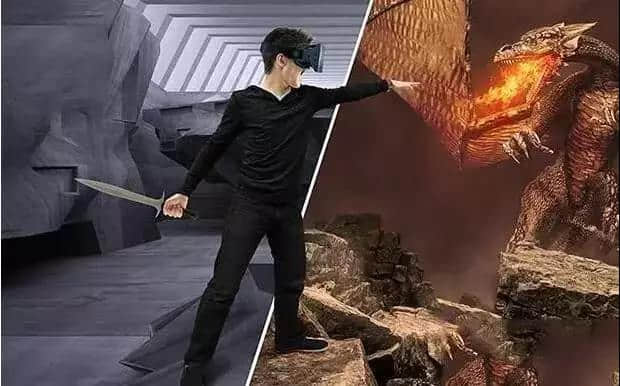Inventory six mainstream VR content platform
2017 has passed half, and the 2016 VR is farther from the year. At present, the VR hardware market is also gradually becoming insipid, not as hot as last year’s scene. We know that mainstream PC
VR glass, such as HTC Vive and Oculus Rift, have their own corresponding VR content distribution platform. Big IP, exclusive game, 3 A masterpiece … all the implicit contention between content platforms is no less than hardware sales. Today, we will anylise the six mainstream VR content distribution platform, to see what the difference between the content platform in the end。
Steam VR
The Steam VR platform is the A VR content distribution platform where players can buy, download, discuss, upload and share games and software on the platform. The platform has an VAC anti-cheating system that supports all games produced by Value and third-party mods that can be used in all Source engine game servers. When the player connects to the Source engine game, the server automatically detects if the VAC is loaded. This anti cheating system will permanently prohibit cheating players from entering the server that opens the VAC system.
In order to better understand the needs of players, Steam VR platform specially set up a favored light system. The system is very simple, the developers upload games to the favored light system, including screenshots, video and related information, STEAMVR player vote to indicate whether the game is interesting. This will help developers to better promote the game, improve the game exposure.
HTC Vive port
In October 2016, HTC Vive officially launched the Mobile VR App store Viveport M developer Beta, unlike the STEAMVR, Viveport M platform in addition to the game, but also shelves a large number of industry video applications.
At the same time, HTC Vive also released the Viveport Arcade for the offline experience store content management and sales platform. Viveport M is suitable for most Android mobile devices, and players can find and experience quality mobile VR applications and 360-degree video content in Viveport m regardless of whether they enter VR mode. The Viveport Arcade, tailored for the offline experience shop, gives Vive developers the opportunity to reach out to those who have not yet purchased Vive, and to make it easier for the VR experience shop operators to obtain the compelling content of VR games through legitimate channels.
Oculus Home
In June 2015, Oculus held a “Step into the Rift” conference in San Francisco, USA, in addition to the release of Oculus Rift CV1, Oculus Vice President Nate Mitchell also officially launched a set of games, video, social, application store in a VR Content Distribution Platform Oculus Home.
Subsequently, Oculus integrated updated the Oculus Home platform application Oculus video streaming content, players not only watch Netflix movies online, but also enjoy the broadcast TV twitch, Vimeo and other videos content. Not only that, Oculus also extends the Oculus Social Alpha Social application, where players can create personal accounts, search for friends, and send friends invitations on the Oculus home platform. In addition, Oculus integrates the Facebook video options into Oculus apps, where players can connect to Facebook and Oculus accounts, and get personalize VR content based on the people they are interested in.
Daydream Home
Google has added a new application center called “Daydream Home” to its VR interface on Google Play.The app has a host of news outlets, such as The New York Times, the Wall Street Journal and CNN, and many video providers, such as Hulu, HBO, Netflix, the NBA, MLB, and other sports leagues, as well as IMAX films. Daydream Home also United Ubisoft, EA and other game manufacturers to provide the content of the game. And Google’s range of mobile apps have also launched a VR version, such as Google Movie, Google Photo, Street View and streaming media platform YouTube. At the same time, daydream Home also undertakes the application distribution and the recommendation responsibility. Players can see application recommendations in the main interface, which are recommended based on the player’s interest.
Inception
Recently, the immersive content-oriented network service provider, inception, announced that it had completed a round of $15 million (about 100 million yuan) of a-level financing. This investment was mainly led by RTL Group. Unlike the 360-degree panoramic video on the web, everything on the Incepiton platform is specially crafted and content-interactive. In addition, the player can experience the original programs created by publishers and copyright owners, the interactive content of episodes, and the quality VR content provided by third-party content channels through inception applications.
VRonline
Through the open platform, Vronline Game Library allows CP to access game products, no audit threshold. Vronline also supports the player’s management and start-up of local VR games. In addition, Vronline allows players to play 3D games in VR mode, which adds to the richness of the game. In addition to the game content, Vronline also offers a variety of multimedia content, including VR video, VR Interactive pictures, VR live broadcast, and so on, which will all be provided to the player in UGC mode. The player uploads the shared video and launches the live broadcast, which can be viewed online through a self-developed VR player. The platform also supports local VR video playback in a variety of video f formats。

The development of VR software and hardware is complementary, but the current development of VR hardware is not satisfactory. Due to the fact that VR’s current holdings are too low, many developers are in a wait-and-see situation, resulting in a lack of content. In order to make up for this lack, many VR manufacturers can only release by their own VR content distribution platform to ensure that hardware develops at the same time. Of course, we also expect to see more quality VR hardware and content coming up in the days to come.








